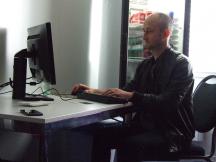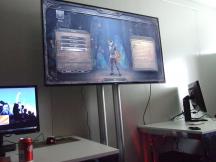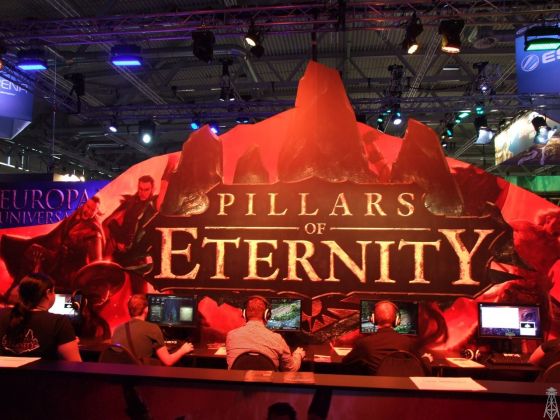Pillars of Eternity Gamescom Presentation
The first game I watched on Thursday at Gamescom was Pillars of Eternity, with Project Director Josh Sawyer, who did all the talking and Lead Programmer Adam Brennecke who played the game.
This article is a representation of what was told to me at Gamescom.
From the start of the development of Pillars of Eternity, Obsidian set out to make an Infinity engine style RPG, a game in the vein of Baldur's Gate, Icewind Dale and Planescape:Torment. Games that emphasize exploration of beautiful 2D environments, party based tactical combat, full party control, six party members and a rich storyline that reacts to the choices you make. In these games and also in PoE, you can take on companions or design a party completely on your own.
The game can be played in one of 4 difficulty modes, ranging from Easy, via Normal and Hard to Path of the Damned. In addition you can combine this with one or both of the other modes, which are an Iron Man mode named Trial of Iron, which has a single save that is used to save your game when you stop playing, but once your party dies you have to start all over again, and Expert mode that removes any of the ‘hand-holding' options that are in the game and introduces perma-death.
We however, played in Easy mode.
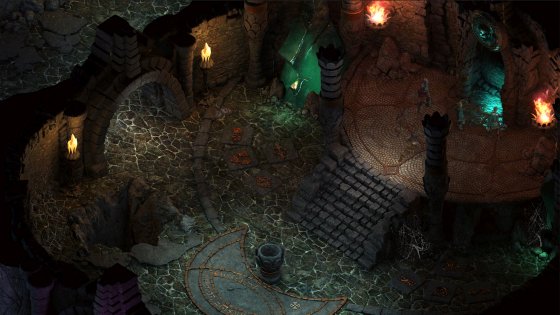
Character creation
The first thing we were shown was the creation of a character. Besides the familiar races, like Humans, Dwarves and Elves, the game has Amaua, an aquatic very large race, which is a race replacing the Orcs, although they are nothing like Orcs personality wise. Then there are Orlans, small creatures that are long haired and cat-eyed and semi feral. And there are the godlike, who have a very unusable appearance and are said by some to be blessed and by others to be cursed by the gods. They are not actually a race by themselves, but are creatures from any of the other races that are touched by the gods, so you can have a human godlike, but also an Amaua godlike. Each of the playable races has also two or more ethnicities to choose from.
Once that is done one of the available classes needs to be selected, from which you can find many classes that should sound familiar, such as Barbarian, Druid, Fighter, Monk, Paladin, Priest, Ranger, Rogue and Wizard. In addition there is also the Chanter (which looks to be a replacement for the Bard) and Cipher class, which has powers related to the soul and mind. We went for the Paladin. The Paladin in PoE is a frontline melee fighter and supporting character. They have a few offence abilities, but mostly they are oriented towards helping their teammates. When you play a Paladin you also have to pick one of the Paladin orders the Paladin is from. These orders are aligned with different personality types. The personality of your character is tracked during the game. If you, for example, would play for the Darcozzi Paladini order, you are associated with being very passionate and clever. If you roleplay your character like that you receive some minor bonuses if you however will roleplay against that you will receive some minor penalties, but these are not as severe as is the case in AD&D where you could eventually fall from grace.
Next in line was the assignment of points to your character's attributes. No repeated throwing of any dices needed in order to get a high amount of total points, you just get a fixed number of points that you can assign to the six stats that are in the game; Constitution, Dexterity, Intellect, Might, Perception and Resolve. I guess almost all of these will sound familiar, with perhaps the possible exception of Resolve, which is used to resists interrupts. It will allow you for example to finish casting a spell even if you are attacked.
Following this we had to define from which culture we are. Your starting culture defines the equipment you start with and also has an implication in conversations. In addition there is a small impact on some of your statistics. We played a Paladin from Old Vailia, which is a swash buckling culture and that starts us out with a breastplate, a rapier and a small shield.
Concluding all that, the background was selected, which is purely role-playing oriented and is used in conversations every now and then.
If you like you could also modify the looks of your character to make it unique and pick a 2D portrait that is befitting your character or use one you prepared yourself beforehand.
All what is keeping us from starting, is selecting a name and we are good to go. In PoE you can create only one character at the start. In this demo four more are given to you. When leveling up your character can improve its attributes and it gets a new ability or talent which will give you a new capability or improve one you already have. As they wanted their backers to experiment with the characters around the mid-level range in order to get a good sense of the abilities your character can get, you are given a sufficient amount of points, abilities and talents at the start.
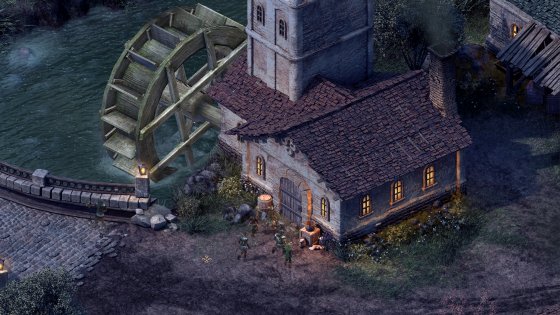
The inn
The backer beta starts in the village of Dyrford, it is a side area in the game and not plot critical. The village is built on top of an old settlement and comes with a dungeon below it. In the village there is a backer defined inn, named The Dracogen Inn, where we find the barman Dengler, named after one of their backers, to rent a room for sleeping. Compared to the Inifinity Engine games, sleeping works differently in PoE. They wanted to make sure the inns in PoE were a bit more compelling to use. As a result your party will get a long term buff when sleeping in one of the better bedrooms of the inn and the more exclusive your room, the better the buff. You can also sleep everywhere outside of an inn if you have camping equipment in your inventory. Sleeping outside is safe and will not get you attacked but will remove any buff you received from sleeping at the inn. They feel this makes sleeping more about the strategic choices of using limited camping resources and not about a random chance of being attacked.
As in the Infinitty Engine games, sleeping restores all your health and the spells you might have used.
At many inns you can also hire additional adventurers. The game has 8 companions each with their own story lines and banter to choose from, but if you want to build your own party members you can do this as well, allowing you to make a party of all dwarves or all wizards.
A quest
In the backer beta there are about 4 quests you can do and some side content you can explore. We did one of the quests involving an ogre who is stealing pigs from a farmer and, obviously, our party decides to take care of it. Ogres in PoE are not only very strong but also intelligent and the only thing that keeps them from being an even bigger thread is that they are extremely paranoid and aggressive towards each other. They prefer to kill other Ogres instead of combining forces. The only thing that can keep Ogres in check is an Ogre matrin. These females are even bigger than the males and also less aggressive. However this specific Ogre is not kept in check and is only causing a lot of trouble.
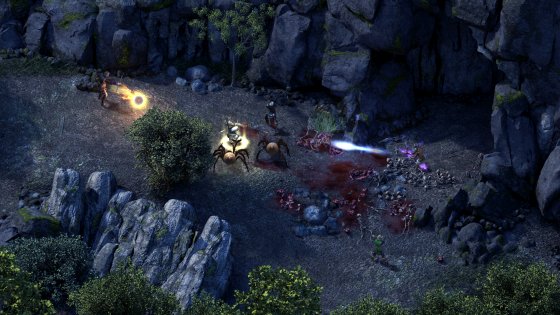
Combat
During combat, Josh explained the usage of Rogues and Fighters. Rogues are very good at causing status effects and once a Rogue is attacking an enemy that is suffering from a negative status effect, such as stun or paralyze, the rogue can automatically sneak attack, which makes the rogue very powerful offensively, but they are still relatively very fragile if someone gets close to them. Fighters on the other hand do not do that much damage in combat. They wanted Fighters to be relatively passive compared to spell casting characters but they did want to make them more involved than they were in the Infinity Engine games, so the Fighter has a number of offensive and defensive abilities they can use.
The strategy part resembles the Infinity Engine game a lot. You pause the game to issue command and unpause it again to see the commands get executed. Pausing the game can be done manually or with one of the many auto-pausing options (like enemy sighted, party member goes down, and over a dozen more). There is also a slow mode option available, where everything moves in slow motion, given you time to issue commands to the party members, without actually pausing the game.
After a combat has been won you get to know the creatures you've fought. They will be entered in the encyclopedia of creatures you are running around with, with which you can check on the lore of the creature but also on its stats to aid you making tactical decisions.
While in combat, you need to keep an eye on your character portraits, which have a green health bar, showing how much long term damage has been inflicted. The portrait itself is also filled with red during combat to show the short term stamina damage, which ends the combat for that character when the portrait is fully filled, but will replenish automatically when the fighting is done.
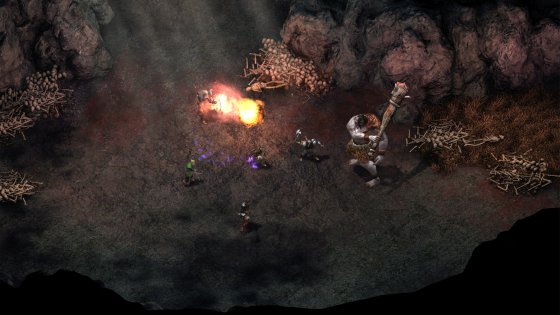
After a couple of fights we reached the Ogre. As mentioned these big guys are intelligent and it is possible to talk him down and solve the quest without a fight and maybe even become his friend, but they did not want to leave us without a dead Ogre, so there was not much talking involved during the encounter leading to a fight, which resulted in slaying the Ogre, with some effort, and gaining the Ogre's head.
Back to the quest
When being defeated a lot of the creatures in the game drop items, which are their body parts. So spiders drop legs, the beetles drop their shells, ogres drop blood, trolls drop skin. These parts can be used in crafting for creating food, potions and scrolls or to enchant your weapon, shield and armor, which makes your enchanted item more powerful and more expensive when selling it. The creatures will not drop loot that you would normally not expect such a creature to have, like a sword.
Solving the Ogre quest gives you a positive reputation in the village as they do not like Ogres. When you solve the quest you are also offered a reward, but you can choose not to take the reward, which will result in you being seen as a benevolent person. Some people think that is great, others will try to take advantage of you because they think you are a chump, but regardless of that, in this case the pig farmer will also give you a piglet he has no use for, and you can take that as your pet, which was one of the stretch goals of the campaign. You can also have a cat, dog, a spider and other critters, but only one at the time. They are purely cosmetic and do not help or hinder you in any way. It just follows you around. At the moment though you cannot give the pet a new name.
The backer beta consists of the town, two wilderness areas, two dungeons and a small cave with an Ogre and spiders. It should be at least 3-5 hours of game play. The game itself is scheduled to be released at the end of the year.
I have always enjoyed the Infinity Engine games, some more than others and although there are several differences between Pillars of Eternity and the Infinity Engine games, to me it does give that vibe I also had when playing any Infinity Engine game, which is great. It looks to be a great time to play RPGs now and for the next year or so, with the current and future releases.
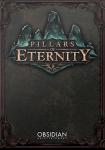
Information about
Pillars of EternityDeveloper: Obsidian Entertainment
SP/MP: Single-player
Setting: Fantasy
Genre: RPG
Combat: Pausable Real-time
Play-time: 40-60 hours
Voice-acting: Partially voiced
Regions & platforms
World
· Homepage
· Platform: PC
· Released: 2015-03-26
· Publisher: Obsidian Entertainment
More information


